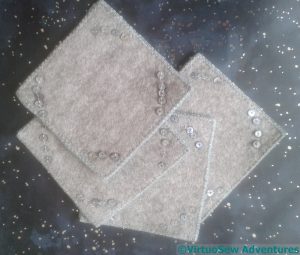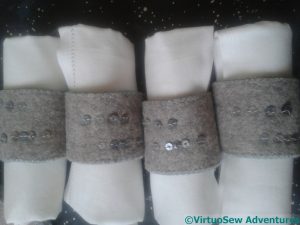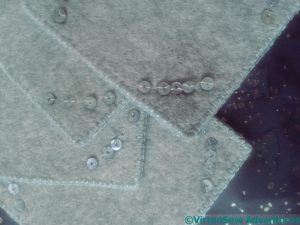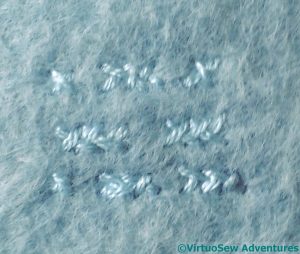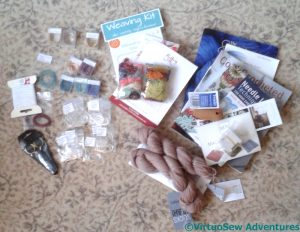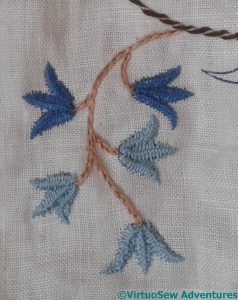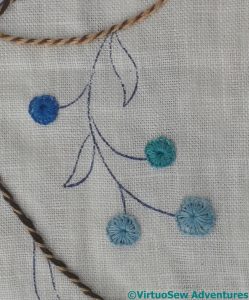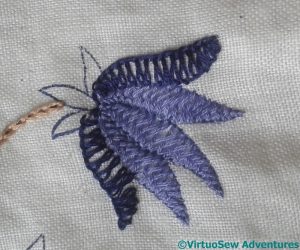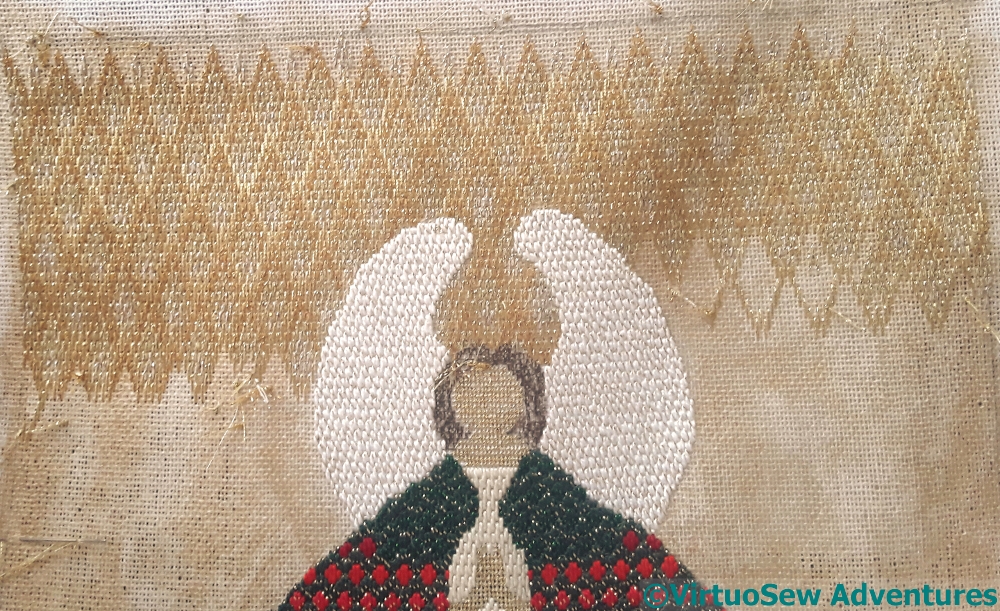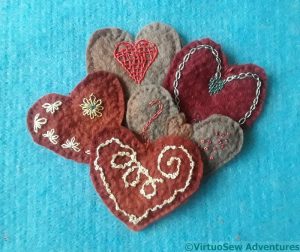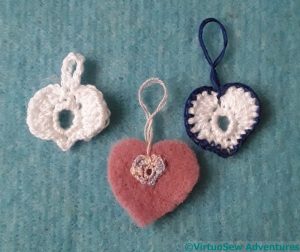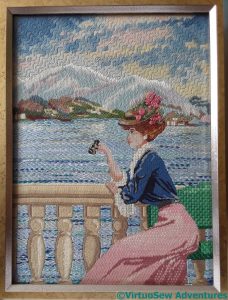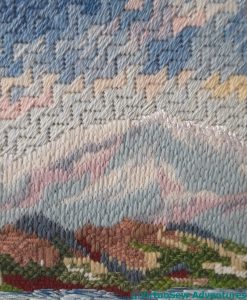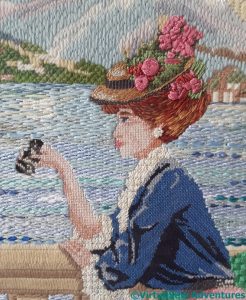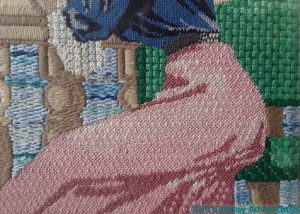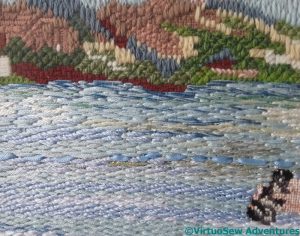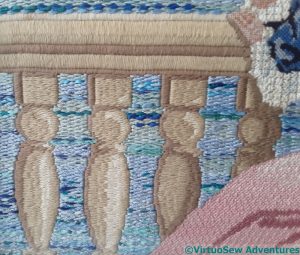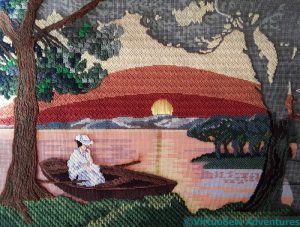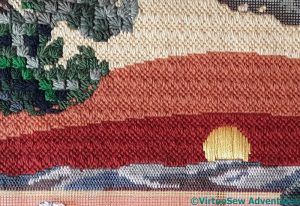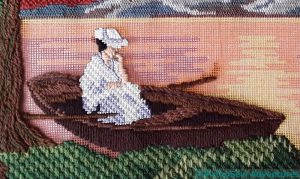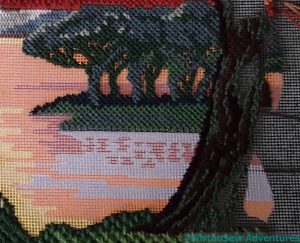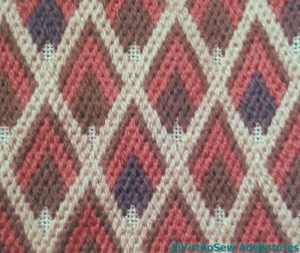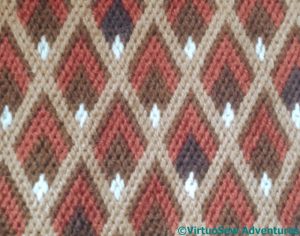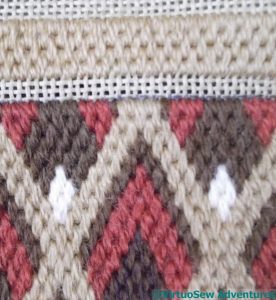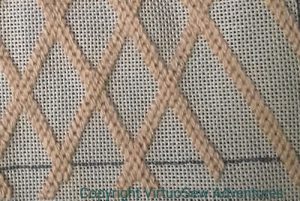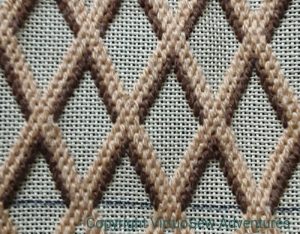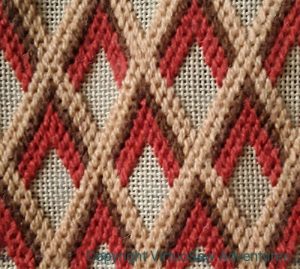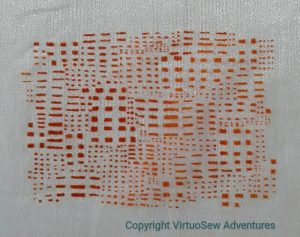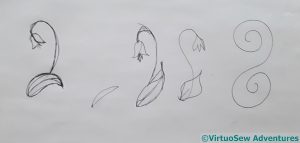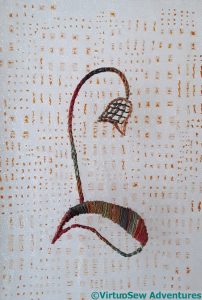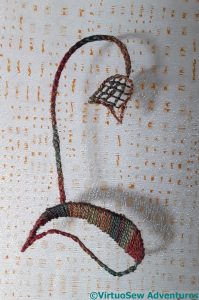Category: General Embroidery
A Wedding Gift
It pays to be as organised as possible when you are dealing with weddings, but I’ve not been very organised in general this year. That said, not knowing what sort of things our friends’ combined taste would run to until two months before the wedding was rather a handicap. In the end, we bought something from the list and then I decided to do a little something extra.
I’ve made a set of coasters and napkin rings in felt, in colours that should work with the crockery they’ve chosen, although they aren’t the same. The two layers of felt are bonded and then blanket stitched together using a vintage silk thread that just happened to work rather well.
And the embellishment is made using tiny sequin-like beads made of shell.
And what is the embellishment, I hear you ask? What else, I hear myself reply, but the initials of our friends’ given names in Morse Code. Fortunately the letters in question are both symmetrical and palindromic, so they work in whatever orientation they are placed. The coasters have each initial twice, in opposite corners, and the napkin rings once each.
As old friends, they know of my proclivities for using Morse Code, so, lest they be disappointed, I have signed each coaster on the back with my initials in Morse Code.
A Very Useful Visit To Harrogate
It’s That time of the year again!
No, not Christmas (not yet!), but the Knitting and Stitching Show in Harrogate. This is my best chance to stock up on the obscure, the intriguing, or the plain difficult to find. It’s also a good chance to meet up with old friends (it was lovely to see Elizabeth again), and sometimes even to make new ones.
This year, as well as some sock yarn and some tangled reel ends of silk (which are a very useful source of odd colours for odd purposes, often in quite fine thread, which might be hard to find), I spent some considerable time looking at, and finally ordering, a new worklight, which I hope will extend my working hours on those days when I can settle to it.
I also bought a couple of books, one on needlelace, which at the moment I have no particular reason for, except that I want, one of these days, to write up my Grandmama’s needlelace tablecloth. I’m sure I will find something I want to work in needlelace. The other is a book of crocheted hats. Something different to do, as a change of pace!
The most important purchases, however, were made at Golden Hinde. The Akhenaten embroidery is going to involve a good many materials and techniques I am only vaguely acquainted with. So I took with me the pricking for Akhenaten, so I could show the sizes and shapes I was trying to fill, and describe what I was trying to achieve. Soon a torrent of purls, twists, and silver plate were tumbling into my basket, accompanied by much advice from Sarah and Sue. I’m still wondering whether I will succeed with this one, but I’m looking forward to the challenge!
Current Travelling Project – Transfer Tablecloth
You may recall that I started on a tablecloth using a Briggs Transfer, as my “travelling project“. I’ve not travelled much, so progress has been somewhat spotty, but when the weather turned very warm while I was playing with my embellisher, I set the wool aside to pick up the tablecloth.
I suppose these might be harebells or bluebells or something similar?
I’ve worked them in Vandyke Stitch, which creates a strong central rib on each petal. It can be a tricky stitch to get just right, because tension makes a huge difference, and I may have worked them a little too tightly.
I’ve also changed each of the four appearances of this figure – there are two colours, and the disposition of those two colours isn’t quite the same in any two. It made it more interesting to stitch!
The next set of sprigs was this design element, and for this I went very old school and traditional – buttonhole wheels!
Furthermore, I used the same idea as with the harebells (if that’s what they are). This time, three colours. The one nearest the stem always dark, the furthest from the stem always light, the other two different on each of the sides of the tablecloth.
These two sprigs went swiftly. One heatwave, and they were done.
This blueish-purple flower won’t be so quick. The inner petals are in closed herringbone stitch. I’m getting better at that, but it is a time consuming stitch and I sometimes tie myself in knots still.
The outer petals are in Basque Stitch, another one that I sometimes tangle. It’s pretty, and creates an intriguing effect. I’ve worked both petals from the base to the time, which produced a few odd contortions. But when it works, I think it’s lovely!
It’s also one of my 17 UFos for 2017 – see Meredithe’s post for more!
Stitching #AHeart4MCR
I don’t usually join in “craftivism”, but I heard about this one just before the Bank Holiday Weekend and decided to. For those who haven’t heard of it, there is now a Facebook Group and if you search for the hashtag “AHeart4MCR” on Instagram or Twitter you will see plenty of responses. The outpouring of love and support for those injured or otherwise affected by the attack last week remains our best, and indeed only, useful response.
Let’s keep it up!
I sat happily stitching these felt hearts through all of Saturday afternoon. There’s nothing complicated about any of them, certainly not by my standards, but each is different, some stitched, some couched, and all the threads are either linen or silk. I didn’t make a pattern, thought, and I should have, because they were all a bit ragged and needed trimming!
Each heart is backed with a second layer of felt to hide any extraneous ends, and I have, as the originator suggested, attached hanging loops.
Then on Sunday, I fished out a crochet hook and thread, and rummaged on Ravelry for a simple crochet heart pattern via Ravelry and tried a trio of those too. You may believe it, but these are all the same pattern, and yet no two of them are alike.
However, they are the first crochet motifs I’ve ever made, and are full of good wishes for those who eventually receive them.
Canvaswork again – The Lady By The Lake
This is my second post of canvaswork for Catherine of Hillview Embroidery.
The Lady By The Lake has a much wider range of stitches and threads in it, including blends of stranded cottons, ribbons, and a variety of wools. The canvas is a double thread canvas which makes it possible to separate the threads and work some of the design in petit point.
I wrote a post about the Lady when I first started blogging, but I have a very much better camera now, and an incentive to take the picture down from the wall. Considering the canvas is still under glass I am very pleased with how the photographs turned out. There are enough different materials and textures in the scene to provide a good workout for thread and stitch selection muscles…
The sky and clouds are all Milanese Stitch, worked in blended Persian yarns with three strands in the needle.
The mountains are in Gobelins Stitch in tapestry wool, and the lakeside hills with their forest and villages are a whole tangle of interesting variations of stitch and thread.
The face and arms were worked in petit point, separating the double threads to create single thread canvas, and worked in stranded cottons (blended). The hair (she didn’t have quite such glorious chestnut hair on the painted canvas itself) is also blended stranded cottons, worked in a sort of long and short stitch. The hat has spider’s web stitch roses on it, and she’s wearing large pearl bead earrings.
It was the idea of experimenting with the skirt that attracted me. I used a bordered Hungarian Stitch, worked in three shades of pearl cotton and combining them to create the impression of five shades in the skirt. It worked!
The blouse is also pearl cotton, this time Linen Stitch, which is effectively the back of Basketweave Tent stitch put on the front.
I changed the wooden, slatted backed bench of the canvas into a padded one so that I could do the upholstery in Reversed Mosaic Stitch.
The lake itself took ages to do – row after row of darning stitch using all sorts of ribbons and threads, including some truly ghastly double knitting acrylic yarn which would have made a dreadfully uncomfortable jumper, but made a very good lake surface, with that slight sparkle you get when there’s just enough breeze to move the water.
The balustrade was worked in Soft Embroidery Cotton. I assumed it was something like limestone, and not marble with a polished surface, so the thread needed to be dull to let other elements shine.
Again, click on the pictures to see more and have fun thinking about what I should have done differently!
Canvaswork – Sunset Study
Catherine, of Hillview Embroidery, is doing an RSN canvaswork course at the moment, and commented in a recent post that the folder of photographs of the work of past students at the back of the studio has been really useful, partly for ideas, and partly just to practice analysing designs and stitches.
I have two canvaswork pieces that use ornamental stitches to represent the textures and colours they depict, both worked when I was a teenager. It’s much easier to analyse someone else’s work than your own, so Catherine, this post (and another, as yet unwritten) is for you!
It was actually the sky that made me buy this particular painted canvas (this was long before I’d tried designing my own!). I think the stitch is Hungarian Point, and since the canvas had such a graphic feel, rather than being painterly, I was quite happy to leave the sky with those sharp colour changes. The pattern in fact runs clean through from bottom to top, but that those same colour changes mask the fact. The heather clad hills are in Plaited Stitch, worked small to help them recede. And the foliage of the tree is Ray Stitch. I do wonder whether I should have done the ray stitch facing downwards, but some of the pines have a slight upward curve, so they are staying as they are.
Almost all the threads in this piece were wool. It’s a fairly large gauge canvas, and again, there’s so much flat colour that blends wouldn’t really be suitable.
The lady in the the punt is Soft Embroidery Cotton for her skin and hair, and tubular synthetic for her gown and hat, and the punt is straight stitches in assorted browns. The tree trunk is effectively in stem stitch, and the bushes at the front are interlocking elongated cross stitches. They look surprisingly bushy, don’t they!
The trees in the distance are in Upright Cross Stitch, which makes a good intermediate texture between the bushes at the front and the distant hillside.
And that near tree? That’s one of the reasons I didn’t finish. I found that not only was I not enjoying the combination of stitches, I was running out of the threads and colours I was using. I threw it in the loft in frustration and disgust and only fished it out again after I’d read Catherine’s post.
The sea is another reason. I still haven’t worked out how to do it, and at the moment, I am still not at all sure I want to.
You can click on all the pictures to see them more closely, so Catherine, your homework is to look at them all, think about what you like and what you’d have done differently.
And if any of you have any suggestions for the sea – let me know!
Shadow Play
I decided, as I stared at the printing of this blocky pattern onto gauze, that I wanted to use the transparency of the gauze as part of the finished effect.
I don’t have a destination in mind for this piece which will give me a theme, so I decided that, in order to highlight that one quality, I would use a single thread (as it happened, a variegated silk), and design a fragment that would allow me to experiment with the effect of stitch cover and openness.
I leafed through books about pattern, saw nothing that gave me the combination I wanted, and then evolved the fragmentary organic sketch on the far left to give me the balance of line and form I was looking for. Incidentally, this is quite possibly the swiftest and shortest progression of any sketched design I’ve ever come up with!
It’s astonishingly difficult to trace a design onto a fabric which is essentially invisible, and still harder, I might add, to follow the lines when you have finally put them there!
I used Hungarian Braided Chain Stitch for the stem, satin stitch for the solid side of the leaf, and Jacobean trellis for the flower-head. Clearly that gives me a solid coverage, and a firm line; I was hoping that the Jacobean trellis might offer a sort of half-shade.
A qualified success, I’d say. The printed pattern doesn’t create a shadow, and the Jacobean trellis shadow isn’t a sort of half-depth.
But, my goodness, the shadow of the stem and the leaf work exactly as I hoped! The gauze itself almost disappears, leaving the printed pattern floating above the surface, and the leaf and flower thrown forward by their shadows.

